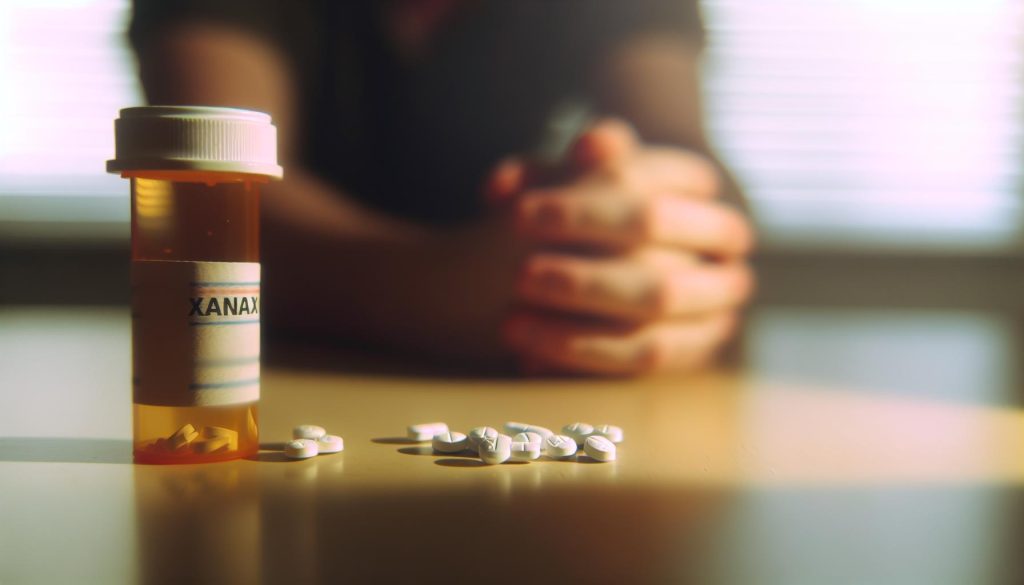Each year, thousands of people misuse Xanax, unaware of the serious dangers associated with its recreational use. While it may seem appealing for its calming effects, the reality is that Xanax can lead to life-threatening consequences, including addiction and overdose. Understanding these fatal risks is crucial for anyone considering its use outside of a medical setting. If you’re seeking relief from anxiety or stress, it’s vital to know that safer, more effective options exist. This article will delve into the alarming realities of Xanax misuse, empowering you with knowledge to make informed decisions about your health and well-being. Stay with us as we explore why it’s essential to avoid recreational use of this powerful medication.
Understanding Xanax and Its Medical Use Risks
Xanax, a brand name for alprazolam, is often prescribed to manage anxiety and panic disorders. While it can be effective for these conditions when used properly, its safety profile diminishes significantly when misused, particularly for recreational purposes. The drug acts rapidly on the brain’s neurotransmitters, specifically enhancing the effects of gamma-aminobutyric acid (GABA), leading to a calming effect. This interaction is the cornerstone of its therapeutic benefits, but it also makes the drug highly susceptible to misuse.
When used recreationally, the risks associated with Xanax escalate dramatically. Because the drug can induce feelings of euphoria, some individuals may find themselves drawn to its non-medical use. This behavior can lead not only to psychological dependence but also to dangerous physiological effects, including impaired motor coordination and cognitive function. Users may engage in risky behaviors while under the influence, unaware of their impaired states and the potential consequences. Moreover, the normalization of Xanax use among peers can create a culture of acceptance surrounding its misuse, a phenomenon often seen with prescription medications in social settings.
It’s crucial to recognize that improper use can have severe repercussions, including overdose, which can be fatal. Users often underestimate the potency of the drug when taken in larger doses or in combination with other substances, particularly alcohol. Such combinations can lead to respiratory depression and loss of consciousness, necessitating immediate medical intervention. Therefore, understanding the medical use of Xanax and acknowledging the potential risks when used outside of prescribed guidelines is foundational in preventing misuse and promoting safer practices for those in need of treatment. Maintaining open communication with healthcare professionals is vital for anyone considering Xanax for anxiety management, ensuring that they receive the support and guidance necessary for safe use.
The Dangers of Recreational Xanax Use

Recreational use of Xanax poses substantial risks, often escalating from casual use to dangerous dependencies and life-threatening situations. Many individuals may initially perceive Xanax as a harmless way to enhance relaxation or mood, unaware of the serious consequences that can arise from misusing this potent medication. The drug primarily functions by enhancing the effects of GABA, a neurotransmitter that inhibits brain activity; while this can provide a sense of calm, it can also lead to severe impairment in coordination, judgment, and overall cognitive function.
The trend of using Xanax recreationally frequently leads individuals down a treacherous path marked by psychological dependence. Users might find themselves increasingly reliant on the drug to cope with stressors or social situations, fostering a dangerous cycle of use. Moreover, the euphoria associated with Xanax can create an illusion of safety, contributing to higher doses being taken. When combined with other depressants, particularly alcohol, the risks multiply exponentially. Mixing these substances can lead to life-threatening conditions such as respiratory depression, where breathing becomes dangerously slow or may stop altogether, a situation that often requires immediate medical attention.
Awareness and education are vital in combating the normalization of recreational Xanax use. The language surrounding its popularity in social settings can make it seem innocuous, but the transition from perceived casual use to addiction is often alarmingly fast. As the culture around prescription medications continues to evolve, it’s crucial for friends and family to recognize the signs of misuse and intervene when necessary. Open discussions about the risks associated with recreational use can help to foster a more informed community, empowering individuals to make healthier choices and seek support when needed.
In conclusion, while Xanax can be beneficial for those who use it as prescribed, its recreational use brings along a host of dangers that can have fatal consequences. Prioritizing safety and being mindful of these risks should guide anyone’s approach to medication and mental health management {{for personalized advice most effectively, consulting a healthcare professional is always recommended}}.
Fatal Consequences of Xanax Overdose

While many people may underestimate the risks associated with Xanax, the reality is that an overdose can lead to catastrophic outcomes, including death. Xanax (alprazolam) is a powerful benzodiazepine that acts by enhancing the effects of gamma-aminobutyric acid (GABA) in the brain. This results in a calming effect, but it also means that the potential for misuse and overdose is significant, particularly in recreational settings where the dosage may not be controlled.
In cases of overdose, individuals may experience severe symptoms including:
- Extreme drowsiness or sedation
- Confusion or disorientation
- Respiratory depression, leading to dangerously slow or stopped breathing
- Loss of consciousness
- Coma
These symptoms can escalate rapidly, necessitating immediate medical intervention. When combined with other substances-especially alcohol or opioids-the risk of fatality increases significantly, as the depressant effects can compound, leading to respiratory failure.
Additionally, even if immediate medical assistance is sought, the risks of long-term damage remain. An overdose can result in cognitive impairments, persistent respiratory issues, and an increased risk of future substance dependence. The reality is that what starts as a casual use of Xanax for relaxation or social anxiety can swiftly spiral into a life-threatening situation, emphasizing the critical need for awareness and caution.
For individuals grappling with anxiety or stress, it’s imperative to seek help from qualified healthcare providers rather than resorting to self-medication. Various safer treatment alternatives are available that do not carry the same risk of overdose and dependency. Consulting with a healthcare professional can lead to more effective and safer strategies for managing anxiety and other mental health conditions.
Signs of Xanax Addiction to Watch For

Recognizing the signs of addiction can be crucial for intervening before the situation escalates. When it comes to Xanax, many individuals start using it for anxiety relief or to cope with stress, but over time, casual use can slip into dependency and addiction. One major warning sign is a growing need to increase the dosage to achieve the same calming effects, known as tolerance. If you’re finding that what’s typically a prescribed amount no longer helps you feel relaxed, this change indicates that your body may be adapting to the drug, potentially signaling an addiction.
Other signs to watch for include changes in behavior or mood, such as increased irritability when not using Xanax or episodes of anxiety or panic when you cannot access the drug. Social withdrawal is also common; someone struggling with Xanax addiction may begin to pull away from friends and family, losing interest in activities they previously enjoyed. This can often coincide with a preoccupation with obtaining the drug, leading to secretive behavior or neglect of responsibilities-both personal and professional.
It’s important to also recognize physical symptoms that might emerge, including drowsiness or fatigue that disrupt daily life, alongside potential coordination issues that can manifest in accidents or injuries. As the addiction deepens, individuals might experience withdrawal symptoms-nervousness, insomnia, sweating, and tremors-when not using the drug, reinforcing the cycle of dependence.
If you or someone you know is exhibiting these signs, it’s essential to reach out for professional help. Consulting with healthcare providers can introduce safer alternatives for managing anxiety and establish a path toward recovery, which not only addresses psychological needs but also mitigates the physical risks associated with Xanax dependency. Remember, recognizing the signs early can make a significant difference in the course of treatment and recovery.
Mental Health Risks Associated with Xanax

Many people turn to Xanax for its calming effects, but the mental health risks associated with its use, especially recreationally, can be significant. This commonly prescribed medication, while effective for anxiety relief, has the potential to exacerbate existing mental health issues or even introduce new ones. Regular recreational use can lead to impaired cognitive function, emotional instability, and heightened anxiety levels once the drug wears off, creating a vicious cycle.
The Impact on Mood and Anxiety
Prolonged use of Xanax can manifest in increased irritability, mood swings, and a heightened susceptibility to anxiety or panic attacks. This paradoxical effect occurs because, although Xanax initially alleviates anxiety, reliance on the drug can lead to emotional numbing and episodes of heightened distress. Individuals may find themselves trapped in a cycle where they become anxious about not having access to Xanax, leading to an increased dependence on the medication for perceived emotional stability.
Cognitive Effects
Using Xanax recreationally can also impair cognitive abilities. Users often report difficulties with memory, concentration, and decision-making. These cognitive deficits can not only affect personal and professional life but can also lead to risky behaviors, as judgment becomes compromised. The inability to think clearly or make sound decisions can exacerbate feelings of anxiety, ultimately heightening dependence on the substance.
Hallucinations and Paranoia
In more severe cases, the misuse of Xanax can induce hallucinations and paranoia, especially when taken in high doses or mixed with other substances, such as alcohol. This disturbing side effect not only jeopardizes the individual’s mental state but can also lead to dangerous situations for themselves and others.
As tempting as it may be to use Xanax for temporary relief from anxiety or stress, the mental health risks are substantial. It’s crucial to explore healthier coping mechanisms with the guidance of healthcare professionals. Alternatives such as therapy, mindfulness practices, and non-addictive medications can provide effective, safer solutions for managing anxiety and improving overall mental health without the detrimental effects associated with recreational Xanax use.
The Impact of Mixing Xanax with Alcohol
Mixing Xanax with alcohol presents a dangerous combination that can drastically amplify the effects of both substances, leading to severe health risks. The central nervous system depressant properties of both Xanax (alprazolam) and alcohol can result in heightened sedation, impaired coordination, and respiratory depression. This potent mix increases the likelihood of blackouts, poor decision-making, and accidents, ultimately jeopardizing both physical and mental well-being.
When alcohol is consumed with Xanax, one may feel a quickened onset of euphoria and relaxation initially; however, this is misleading. As both substances begin to interact, the resulting respiratory distress can lead to life-threatening situations, including coma or death due to insufficient oxygen intake. Particularly in higher doses, the synergy of these drugs can precipitate overdose-a risk that is significantly heightened in casual users who may underestimate their tolerance or the effects of alcohol.
Signs of Harmful Interactions
It’s crucial for individuals to be aware of the warning signs indicative of dangerous interactions, which include:
- Extreme drowsiness: Persistent fatigue or an inability to stay awake.
- Confusion: Lapses in memory or incoherent speech.
- Breathing difficulties: Shortness of breath or irregular breathing patterns.
- Loss of coordination: Difficulty walking or maintaining balance.
If any of these symptoms are observed, it’s vital to seek medical attention promptly.
In addition to immediate risks, the long-term consequences of habitual mixing can lead to addiction and the development of dependence on both substances. Individuals may find themselves trapped in a cycle where they require increasing doses to achieve the same effects, potentially leading to escalating health problems and an overdose. If you’re considering using Xanax or alcohol for relaxation or anxiety management, it’s essential to consult with healthcare professionals who can guide you toward safer alternatives. There are multiple evidence-based therapies and treatments available, which can help enrich your mental health without the peril that accompanies combining these substances.
Safe Alternatives to Manage Anxiety
Finding strategies to effectively manage anxiety is crucial, especially in a world where stressors seem ever-present. Rather than resorting to medications like Xanax, which can carry significant risks, including addiction and dangerous interactions, exploring safe alternatives can lead to sustainable mental health benefits. These alternatives not only help alleviate anxiety but also promote overall well-being without the side effects commonly associated with pharmaceuticals.
Mindfulness and Relaxation Techniques
One effective approach to managing anxiety is through mindfulness practices. Mindfulness meditation encourages individuals to focus on the present moment, enhancing awareness of thoughts and feelings without judgment. Research has shown that regular mindfulness practice can lead to reductions in anxiety levels and improved emotional regulation. Techniques such as deep breathing exercises, progressive muscle relaxation, and guided imagery are also beneficial. For example, setting aside just ten minutes each day to engage in deep breathing can significantly reduce anxiety.
Physical Activity
Regular physical activity is another powerful tool in combating anxiety. Exercise promotes the release of endorphins-chemicals in the brain that act as natural painkillers and mood elevators. Activities like jogging, swimming, or yoga not only boost physical health but are also effective in reducing symptoms of anxiety. A brisk walk in nature can further amplify the calming effects, as being outdoors has been shown to improve mood and reduce stress.
Nutritional Considerations
What you eat can have a profound impact on your mental health. Incorporating a balanced diet rich in fruits, vegetables, whole grains, and lean proteins can support overall brain health. Certain nutrients, such as omega-3 fatty acids found in fish and nuts, are known to reduce anxiety levels. Furthermore, limiting caffeine and sugar can prevent spikes in anxiety symptoms, allowing for a more stable emotional state throughout the day.
Professional Support
Finally, seeking professional help is paramount for those struggling with anxiety. Cognitive-behavioral therapy (CBT) is one of the most effective treatments for anxiety disorders. It helps individuals identify and challenge negative thought patterns, equipping them with coping strategies to manage their emotions. Additionally, support groups may offer a community of understanding that provides comfort and shared experiences.
By adopting these safe alternatives, individuals can effectively manage anxiety without the inherent risks associated with substances like Xanax. Always consult with healthcare professionals for personalized advice, especially if anxiety symptoms persist. Taking proactive steps toward mental wellness is empowering and can lead to a more fulfilling life.
How to Seek Help for Xanax Dependence
Recognizing the signs of dependence on Xanax can be an overwhelming realization, but taking the first step toward help is crucial for recovery. The journey to overcoming dependence often begins with acknowledging that you need assistance. If you or someone you care about is struggling with reliance on this medication, it’s essential to remember that seeking help is a sign of strength and an important move toward regaining control over one’s life.
When considering , start by reaching out to healthcare professionals who specialize in addiction and mental health. This may include your primary care physician, a psychiatrist, or a licensed therapist. They can provide a comprehensive assessment of your situation and guide you toward appropriate treatment options. For those hesitant to speak to a professional in person, many resources are available, such as hotlines and online therapy services that can provide confidential support.
Understand Treatment Options
Treatment for Xanax dependence may involve several approaches, including:
- Medical Detoxification: In some cases, a supervised detox may be necessary to safely manage withdrawal symptoms.
- Cognitive Behavioral Therapy (CBT): This therapeutic approach empowers individuals to change negative thought patterns and develop healthier coping strategies.
- Support Groups: Programs such as Narcotics Anonymous (NA) offer community support and shared experiences, providing a sense of belonging.
- Medication-assisted Treatment: In certain situations, doctors may prescribe alternative medications to help alleviate withdrawal symptoms and reduce cravings.
Understanding that recovery is a process and may take time is essential. Engaging in a structured program can facilitate not only physical health but also emotional and psychological healing.
Building a Support System
Open communication with friends and family can provide essential emotional support during difficult times. Encouraging your loved ones to engage in your recovery journey fosters a sense of accountability. They can assist in identifying triggers and help you stay focused on your recovery goals.
Connecting with professionals who understand the complexities of addiction will equip you with tools and techniques to manage stressors effectively.
Taking proactive steps to seek help can significantly improve your well-being and overall quality of life. Remember, no one has to navigate this journey alone; support is available, and recovery is possible with the right resources and guidance. Always consult with healthcare professionals for personalized advice, and focus on creating a healthier, more fulfilling future.
Legal Implications of Xanax Misuse
Engaging in recreational use of Xanax can lead to severe legal consequences that extend far beyond health risks. Possession of Xanax without a valid prescription is illegal in many jurisdictions and can result in criminal charges that impact one’s future significantly. For instance, individuals caught with Xanax could face misdemeanor or felony charges, depending on the quantity found and the specific laws in their location. Such charges often come with fines, community service, or even jail time, which tarnish one’s record and can influence future opportunities in employment, housing, and education.
In addition to criminal penalties, misuse of Xanax can result in civil liability, especially if the individual causes harm to others while under the influence. For example, driving while impaired can lead to serious legal repercussions including DUI charges, which carry hefty fines, mandatory rehabilitation programs, and a potential loss of driving privileges. Furthermore, if someone were to harm another while intoxicated, they might also face lawsuits for damages, adding a financial burden on top of legal issues.
Regulatory and Enforcement Actions
The Drug Enforcement Administration (DEA) categorizes Xanax as a Schedule IV controlled substance, indicating a recognized potential for abuse and dependence. This classification means that law enforcement agencies actively monitor distribution and usage patterns. Engaging in the illicit buying or selling of Xanax-whether through unauthorized prescriptions or unofficial sources-can attract scrutiny from regulatory agencies, leading to investigations and potential criminal charges for trafficking.
Importance of Legal Awareness
Understanding the is crucial for anyone considering its recreational use. Being informed not only highlights the risks associated with illegal activities but also serves as a reminder of the importance of prescription medications being used as directed by healthcare professionals. It’s vital to prioritize health and well-being over fleeting recreational experiences and to consult with a doctor about safe and legal alternatives to manage anxiety or related conditions.
Legal issues surrounding Xanax misusage emphasize the need for responsible usage and adherence to medical guidance. Always bear in mind that the path to recovery and well-being can take many forms, and seeking help through proper channels is both a wise and legally sound decision.
Personal Stories: The Reality of Xanax Abuse
Many individuals who start using Xanax for its prescribed purpose often find themselves trapped in a cycle of abuse without realizing the dangers that lurk ahead. One striking example is that of a young woman named Sarah. Initially prescribed Xanax for her crippling anxiety, she found it to be an effective means of coping with her condition. However, as her tolerance increased, she began to seek out the drug recreationally to experience the euphoric high it provided. This shift marked the beginning of a tumultuous journey into substance abuse that led to severe consequences.
Sarah’s story isn’t unique. Many people who misuse Xanax experience a gradual detachment from reality. The powerful effects of the drug can create a false sense of well-being, prompting users to ignore the physical and emotional toll it is taking. As dependence builds, daily activities and relationships often suffer. For Sarah, her social life crumbled, as she isolated herself in order to use Xanax. Family members noticed changes in her behavior, but she dismissed their concerns, convincing herself that she could control her usage.
The repercussions of Xanax abuse extend beyond individual experiences. Many users report intense withdrawal symptoms that often drive them back to usage, creating a painful cycle. In Sarah’s case, the withdrawal led to debilitating anxiety and panic attacks, which perpetuated her need for the drug. This vicious cycle reflects a broader reality faced by many who misuse Xanax: the struggle between the desire to overcome anxiety and the overpowering grip of addiction.
Stories like Sarah’s serve as cautionary tales that highlight the importance of addressing mental health issues through safer, healthier methods. Seeking alternatives such as therapy, mindfulness practices, or holistic remedies can provide a more sustainable path to managing anxiety. Engaging with healthcare professionals about these options can empower individuals to reclaim their lives without the fatal risks associated with recreational Xanax use. By sharing these narratives, we can raise awareness about the stark realities of Xanax abuse and encourage respectful conversations about mental health treatment.
Finding Support: Resources for Recovery
Finding the right support is crucial when it comes to overcoming dependencies like those associated with recreational Xanax use. Many individuals feel overwhelmed and isolated, but they should know that help is available. Establishing a recovery network can be the first step toward reclaiming health, both mentally and physically.
To begin, reaching out to healthcare professionals who specialize in addiction treatment can provide tailored guidance and support. Options such as therapy, counseling, and medication management are all valuable resources. Specifically, cognitive-behavioral therapy (CBT) has proven effective in addressing the underlying mental health issues that may lead to substance misuse. This approach not only helps in understanding the patterns of addiction but also equips individuals with coping strategies to manage anxiety without resorting to drugs.
Support groups, such as Alcoholics Anonymous (AA) and Narcotics Anonymous (NA), offer community-based assistance for those struggling with addiction. These groups cultivate an environment of shared experiences and accountability, making it easier for individuals to discuss their challenges and successes. Members often share stories, strategies, and encouragement, reinforcing that recovery is a journey best navigated with others who understand the struggles involved.
Furthermore, consider exploring holistic health practices that promote overall well-being. Options like mindfulness, yoga, and meditation have shown promise in reducing anxiety naturally. Engaging in regular physical activities and maintaining a healthy diet are also crucial steps in fostering resilience against cravings and withdrawal symptoms.
In addition to these recovery methods, seeking information from credible resources is essential. Websites and organizations dedicated to addiction recovery can offer invaluable information, from educational content to listings of local treatment facilities. Empowering oneself with knowledge can facilitate informed decisions and pave the way for a healthier life free from the dangers of Xanax misuse. Remember, the journey to recovery is challenging, but the right support system can make all the difference.
Expert Insights: Medical Perspectives on Xanax Use
Xanax, a commonly prescribed medication for anxiety and panic disorders, is often misused due to its sedative effects. However, healthcare professionals emphasize the stark distinction between therapeutic use and recreational abuse. Using Xanax without medical supervision can lead to a range of serious health risks, highlighting the need for responsible medication practices. In fact, the abuse of benzodiazepines like Xanax is particularly concerning in psychiatric settings, where the potential for developing tolerance and dependence is high.
A significant concern among medical experts is the risk of overdose. Xanax works by enhancing the effects of the neurotransmitter GABA (gamma-aminobutyric acid), which is crucial for regulating brain activity. While this mechanism can effectively alleviate anxiety, it also means that taking too much can depress the central nervous system, leading to respiratory failure and death. Studies show that the combination of Xanax with other substances, particularly opioids or alcohol, increases the risk of fatal overdose exponentially. Therefore, those considering the recreational use of Xanax should be acutely aware of this devastating potential.
Additionally, long-term use of Xanax can lead to significant mental health challenges, including cognitive decline and memory impairment. Regular users may experience heightened anxiety when not taking the drug, creating a vicious cycle of dependency. Healthcare providers frequently point out that the body can become accustomed to benzodiazepines, necessitating higher doses to achieve the same calming effects. This escalation can make it increasingly difficult for individuals to withdraw from the drug, often requiring specialized medical intervention for safe cessation.
In summary, the use of Xanax outside a medical framework poses several profound health risks. Individuals struggling with anxiety should communicate openly with healthcare providers to explore safer, more effective alternatives. Engaging with trained professionals can lead to healthier coping mechanisms, including therapy and lifestyle changes, ensuring a balanced approach to mental health without resorting to potentially lethal substances. Always prioritize safety and consult with healthcare experts when considering treatments for anxiety.
Frequently Asked Questions
Q: What are the risks of using Xanax recreationally?
A: Using Xanax recreationally can lead to severe side effects, including respiratory depression, overdose, and addiction. These risks escalate when combined with other substances, especially alcohol. For detailed insights, refer to the dangers associated with recreational use outlined in the article.
Q: How does Xanax affect the brain when misused?
A: Recreational use of Xanax alters brain chemistry, impacting neurotransmitter levels and leading to dependency. It can cause mood swings, cognitive impairment, and increased anxiety when the drug wears off. Understanding these effects is crucial for recognizing risks associated with misuse.
Q: Why is Xanax considered dangerous in combination with other drugs?
A: Xanax can dangerously interact with other sedatives and depressants, leading to heightened sedation and respiratory failure. Combining Xanax with alcohol significantly increases the risk of overdose. Learn more about these interactions to stay safe.
Q: What are the signs of a Xanax overdose?
A: Signs of Xanax overdose include extreme drowsiness, confusion, respiratory distress, and loss of consciousness. Immediate medical attention is critical if these symptoms occur. Recognizing overdose signs is vital for intervention, especially for recreational users.
Q: Can recreational use of Xanax lead to long-term health issues?
A: Yes, chronic recreational use of Xanax can result in lasting health problems such as memory deficits, mood disorders, and physical health issues like liver damage. Acknowledging these potential long-term consequences is essential for informed decision-making.
Q: What should I do if someone is addicted to Xanax?
A: If someone is struggling with Xanax addiction, encourage them to seek professional help. Effective treatment options exist, including therapy and rehabilitation programs, which can guide recovery. Knowing when and how to support loved ones in seeking help is critical.
Q: Why is it important to consult a healthcare professional about Xanax use?
A: Consulting a healthcare professional provides insight into the safe use of Xanax and its alternatives. Personalized advice is essential for managing anxiety without the risks associated with recreational use. Always prioritize professional guidance for medication management.
Q: What legal issues can arise from recreational Xanax use?
A: Recreational use of Xanax can result in legal consequences, including arrest and prosecution for possession without a prescription. Understanding the legal implications is crucial to avoid serious repercussions and promotes safer choices regarding medication use.
Closing Remarks
Recreational use of Xanax poses significant risks that can lead to life-threatening consequences. It’s crucial to understand the dangers associated with misuse and seek healthier coping mechanisms for anxiety and stress. If you or someone you know is struggling with substance use, consider exploring our resources on addiction recovery and mental health support.
For those looking for more information, check out our articles on the differences between benzodiazepines like Xanax and Ativan, or learn about safer alternatives for anxiety management. Empower yourself with knowledge and take action today towards a healthier lifestyle. Remember, your well-being matters-consult a healthcare professional for personalized advice tailored to your needs. Join the conversation and share your thoughts below; we’re here to support you on your journey to wellness!












